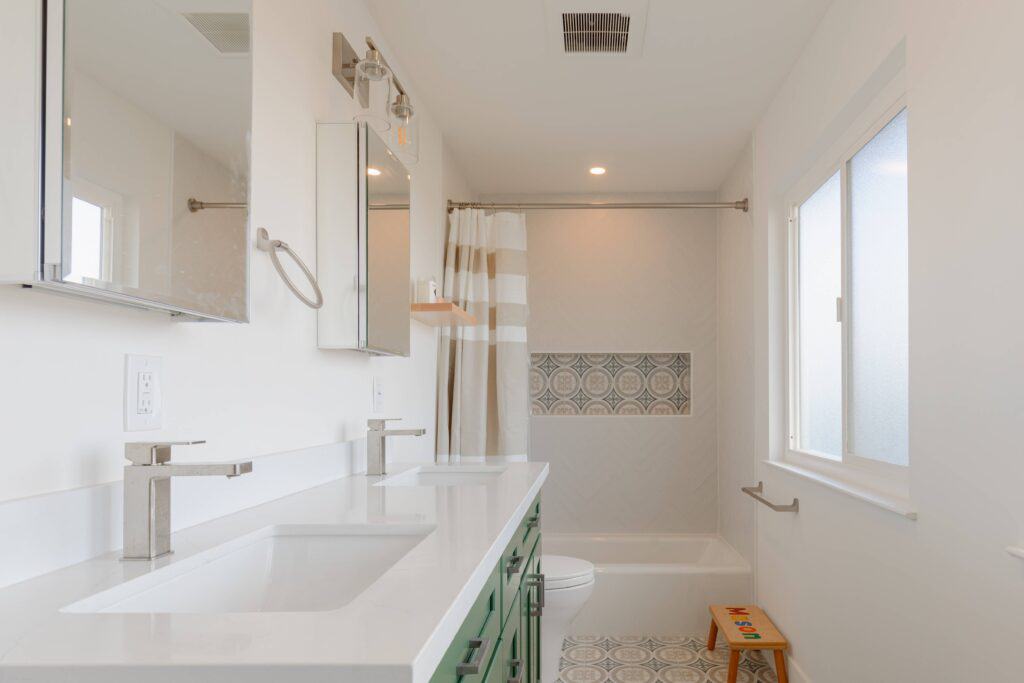Bathroom Remodeling in Livermore
Transform Your Bathroom Locally
Experience outstanding bathroom remodeling services with Creekside Pro Construction, enhancing your home’s comfort and style.
Why Select Our Services
Advantages of Remodeling Your Bathroom

Your Local Specialists
About Creekside Pro Construction in Livermore
At Creekside Pro Construction, we focus on delivering quality bathroom renovations across Alameda County. Our team of skilled bathroom remodelers in Livermore, CA, brings a wealth of knowledge and a sharp design perspective. Whether you envision a master bathroom renovation or a simple redesign, trust us to bring your ideas to life. Count on us as your bathroom contractors, ensuring a smooth and satisfying renovation journey.

Our Remodeling Process
How We Transform Your Space


Understanding Bathroom Remodeling
The Importance of Professional Renovations
Bathroom remodeling is not just about appearance; it’s about improving the functionality and efficiency of your space. At Creekside Pro Construction, we recognize the significance of a well-designed bathroom. Our proficiency in bathroom redesign ensures that each project meets the highest standards. Serving Alameda County and beyond, our bathroom remodeling services cater to the unique needs of homeowners in Livermore, CA. Contact us today at 925-445-7684 to begin your renovation journey.
View Our Bathroom Remodeling Services
About Creekside Pro Construction
Contact us
Before its incorporation in 1796 under the Franciscan Mission San Jose, located in what is now the southern part of Fremont, the Livermore area was home to some of the Ohlone (or Costanoan) native people. Each mission had two to three friars and a contingent of up to five soldiers to help keep order in the mission and to help control the natives. Like most indigenous people in California, the natives in the vicinity of Mission San Jose were mostly coerced into joining it, where they were taught Spanish, the Catholic religion, singing, construction, agricultural trades and herding-the Native Californian people originally had no agriculture and no domestic animals except dogs. Other tribes were coerced into other adjacent missions. The Mission Indians were restricted to the mission grounds where they lived in sexually segregated “barracks” that they built themselves with padre instruction. The population of all California missions plunged steeply as new diseases ravaged the Mission Indian populations-they had almost no immunity to these “new to them” diseases, and death rates over 50% were not uncommon.
The Livermore-Amador Valley after 1800 to about 1837 was primarily used as grazing land for some of the Mission San Jose’s growing herds of mission cattle, sheep and horses. The herds grew wild with no fences and were culled about once a year for cow hides and tallow-essentially the only money-making products produced in California then. The dead animals were left to rot or feed the California grizzly bears which then roamed the region. The secularization and closure of the California missions, as demanded by the government of Mexico, from 1834 to 1837 transferred the land and property the missions claimed on the California coast (about 1,000,000 acres (400,000 ha) per mission) to about 600 extensive ranchos. After the missions were dissolved, most of the surviving Indians went to work on the new ranchos raising crops and herding animals where they were given room and board, a few clothes and usually no pay for the work they did-the same as they had had while working in the missions. Some Indians joined or re-joined some of the few surviving tribes.
The about 48,000-acre (19,000 ha) Rancho Las Positas grant, which includes most of Livermore, was made to ranchers Robert Livermore and Jose Noriega in 1839. Most land grants were given with little or no cost to the recipients. Robert Livermore (1799-1858) was a British citizen who had jumped from a British merchant sailing ship stopping in Monterey, California, in 1822. He became a naturalized Mexican citizen who had converted to Catholicism in 1823 as was required for citizenship and legal residence. After working for a number of years as a majordomo (ranch foreman), Livermore married on 5 May 1838 the widow Maria Josefa de Jesus Higuera (1815-1879), daughter of Jose Loreto Higuera, grantee of Rancho Los Tularcitos, at the Mission San José. Livermore, after he got his rancho in 1839, was as interested in viticulture and horticulture as he was in cattle and horses, despite the fact that about the only source of income was the sale of cow hides and tallow. In the early 1840s he moved his family to the Livermore valley to his new rancho as the second non-Indian family to settle in the Livermore valley area, and after building a home he was the first in the area in 1846 to direct the planting of vineyards and orchards of pears and olives. Typical of most early rancho dwellings, the first building on his ranch was an adobe on Las Positas Creek near the western end of today’s Las Positas Road. After the Americans took control of California in 1847 and gold was discovered in 1848, he started making money by selling California longhorn cattle to the thousands of hungry California Gold Rush miners who soon arrived. The non-Indian population skyrocketed, and cattle were suddenly worth much more than the $1.00-$3.00 their hides could bring. With his new wealth and with goods flooding into newly rich California, in 1849 Livermore bought a two-story “Around the Horn” disassembled house that had been shipped about 18,000 miles (29,000 km) on a sailing ship around Cape Horn from the East Coast. It is believed to be the first wooden building in the Livermore Tri-Valley.
Learn more about Livermore.

